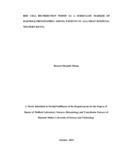RED CELL DISTRIBUTION WIDTH AS A SURROGATE MARKER OF HAEMOGLOBINOPATHIES AMONG PATIENTS IN AGA KHAN HOSPITAL, WESTERN KENYA
Abstract
Red cell distribution width (RDW) measures the morphological diversity of red blood cells (rbcs) per volume rbcs. Such diversity, characterized by significant reticulocytosis and rbcs variation in size(anisocytosis) and shape(poikilocytosis) is common in heightened erythropoiesis, typical of marked haemolysis. Haemoglobinopathies are hereditary haemoglobin disorders characterized by haemolytic anaemia and are highly prevalent among children in malaria-endemic Western Kenya’s Lake Victoria basin counties. As in other low-income countries, timely haemoglobinopathy detection in Kenya is hampered by lack of affordable methods, hindering timely detection of many hemoglobinopathy cases. The RDW is cheaper as it is easily measured as a haematological index in complete blood count (CBC), routinely generated by modern haematology autoanalysers. Despite studies showing its potential as a haemoglobinopathy biomarker, RDW has not been rigorously evaluated, including in Kenya. This study aimed to determine the utility of RDW as a biomarker for discriminating individuals with and without haemoglobinopathy in Western Kenya. This was a cross-sectional hospital-based retrospective comparative study of 488 study participants aged 1 month to 66 years, with respective RDW values known and confirmed haemoglobinopathy status, diagnosed at Aga Khan Hospital, Kisumu, and its satellite centers in Western Kenya from January 2015 to December 2020. Sample size was calculated using Cochran’s’ formula. Data were obtained from the hospital laboratory database and analyzed using SPSS version 23. Haemoglobinopathy profile was summarised as frequencies and percentages and presented in bar-graphs and pie-charts. Demographics variations across groups was analyzed using Chi square. Values for RDW for the haemoglobinopathy-free (control) group were not normally distributed and so the median and interquartile range (IQR) were used as descriptive statistics and in deriving the reference cut-off value for haemoglobinopathy detection. The cut-off value was computed as the upper limit of the 95% confidence interval (CI) and values greater than this indicated a diagnosis of haemoglobinopathy. Kruskal-Wallis tests was used to determine RDW variation among population groups; Dunn’s post hoc test within groups and Mann Whitney U between two groups. Majority of the patients were from the Kisumu station (49.0%, n=239) followed by Busia (15.4%, n=75), Homabay (12.3%, n=60) while the rest were distributed in small numbers among the rest of the stations (p<0.0001). Most cases had HbAS, 41.7% (n=103), followed by HbSS β-Thal, 25.1% (n=62); HbSS, 18.2% (n=45); HbSS+HbF, 8.1% (n=20); Hbβ-thal, 3.6% (n=9); HbAS+β-thal, 2.4% (n=6); and HbAS+HbF, 0.8% (n=2). Overall median RDW for control group was 14.5, IQR=2.7;95%CI=9.1-19.9, giving reference cut-off limit of 19.9 while for overall haemoglobinopathies combined was 20.7(IQR=8.3), p<0.0001. It did not differ significantly between males (14.55[IQR=1.90]) and females (14.2[IQR=2.40]), p=0.089. It varied significantly with age (p<0.05) being highest for <5year-olds, 19.0 (IQR=7.1), followed by 6-12year-olds, 15.5 (IQR=8.2) and >12-year-olds, 14.1 (IQR=2.8), respectively. Haemoglobinopathies whose RDW was higher than the cut-off value of 19.9 were: HbSS, HbSS+β-thal, HbSS+HbF, HbAS+HbF, HbAS+β-thal but not simple HbAS and beta thalassemia. For combined haemoglobinopathies, RDW cut-off limit showed, sensitivity, specificity, and Youden Index of 55.1%, 94.2%, and 74.6%; positive and negative predictive validity, 90.7% and 67.2%; positive and negative likelihood ratio, 9.5 and 0.476; and odds ratio,19.86 (10.9-36.2 CI). The RDW showed promise as a hemoglobinopathy diagnostic, rather than screening biomarker, with possibility of improved overall performance with cut-off limits reference group drawn from the healthy population thus need evaluation using prospective data.

